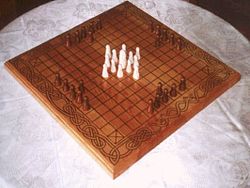Tafl games

A reconstructed Hnefatafl gameboard
|
|
| Years active | 4th–12th centuries |
|---|---|
| Genre(s) |
Board game Abstract strategy game |
| Players | 2 |
| Setup time | < 1 minute |
| Playing time | Typically 5–20 minutes |
| Random chance | None |
| Skill(s) required | Strategy, tactics |
| Synonym(s) | Hnefatafl |
Tafl games are a family of ancient Germanic and Celtic strategy board games played on a checkered or latticed gameboard with two armies of uneven numbers, representing variants of an early Scandinavian board game called tafl or hnefatafl in contemporary literature.
Although the size of the board and the number of pieces varied, all games involved a distinctive 2:1 ratio of pieces, with the lesser side having a king-piece that started in the centre. No complete, unambiguous description of the rules of a tafl game exists, but the king's objective was to escape to (variously) the board's periphery or corners, while the greater force's objective was to capture him. The attacking force has the natural advantage at the start of each game, likely indicating an important cultural aspect by mimicking the success of Viking raids. Another cultural indication of the king is that importance of the Viking chiefs' presence in battle. Although the kings of Europe later claimed divine rule and sat upon the throne rather than bodies in the battlefield, it was essential for a Viking chief to be considered an equal in war. The importance of war is also reflected in Hnefatafl because it is a war strategy game, which can indicate an important reason why the gaming boards have been found with males of all ages. In Balnakeil, a male skeleton between the ages of 8 and 13 was found with weapons and a Hnefatafl board game. Vikings tended to take boys onto the battlefield with them, which explains why young boys also played these war-strategic board games.
There is also some controversy over whether some tafl games (i.e. Hnefatafl and Tawlbwrdd) may have employed dice. Tafl spread everywhere the Vikings traveled, including Iceland, Britain, Ireland, and Lapland. Versions of Tafl, comprising Hnefatafl, Alea Evangelii, Tawlbwrdd (Wales), Brandubh, Ard Rí, and Tablut, were played across much of Northern Europe from earlier than 400 B.C. until it was supplanted by chess in the 12th Century.
...
Wikipedia
